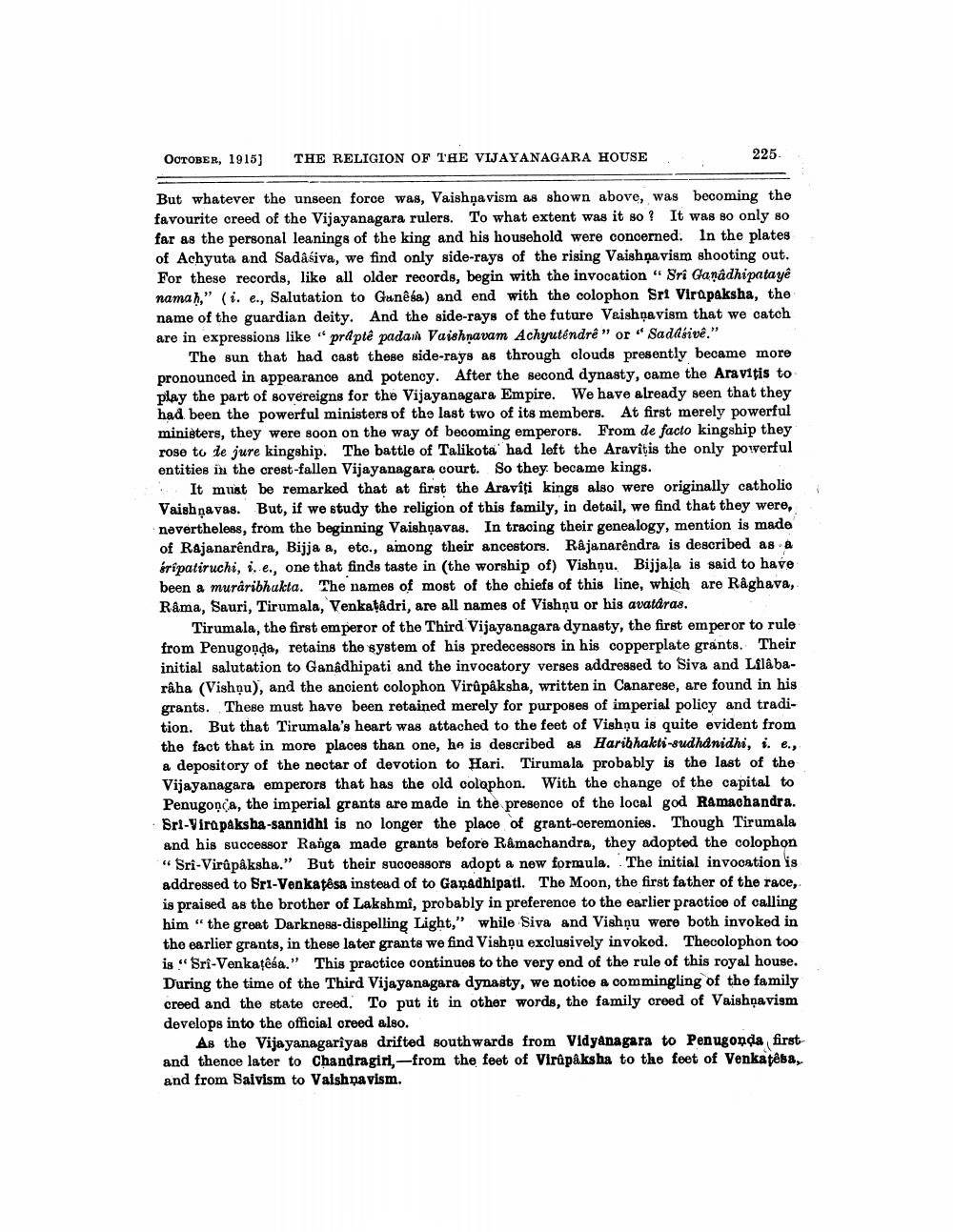________________
OCTOBER, 1915)
THE RELIGION OF THE VIJAYANAGARA HOUSE
225
But whatever the unseen force was, Vaishộavism as shown above, was becoming the favourite creed of the Vijayanagara rulers. To what extent was it so? It was so only so far as the personal leanings of the king and his household were concerned. In the plates of Achyuta and Sadasiva, we find only side-rays of the rising Vaishnavism shooting out. For these records, like all older records, begin with the invocation " Sri Ganadhipatayê namah," (i. e., Salutation to Ganêba) and end with the colophon Sri Virupaksha, the name of the guardian deity. And the side-rays of the future Veishnavism that we catch are in expressions like "praptê padai Vaishnavam Achyutendre" or "Saddsive."
The sun that had cast these side-rays as through clouds presently became more pronounced in appearance and potency. After the second dynasty, came the Ara vitis to play the part of sovereigns for the Vijayanagara Empire. We have already seen that they had been the powerful ministers of the last two of its members. At first merely powerful ministers, they were soon on the way of becoming emperors. From de facto kingship they rose to de jure kingship. The battle of Talikota had left the Aravitis the only powerful entities in the crest-fallen Vijayanagara court. So they became kings.
It must be remarked that at first the Araviti kings also were originally catholio Vaishṇavas. But, if we study the religion of this family, in detail, we find that they were, nevertheless, from the beginning Vaish avas. In tracing their genealogy, mention is made of Rajanarendra, Bijja a, etc., among their ancestors. Râjanarendra is described as a sripatiruchi, i.e., one that finds taste in the worship of) Vishnu. Bijjala is said to have been a muraribhukta. The names of most of the chiefs of this line, which are Raghava, Rama, Sauri, Tirumala, Venkatadri, are all names of Vishnu or his avatdras.
Tirumala, the first emperor of the Third Vijayanagara dynasty, the first emperor to rule from Penugonda, retains the system of his predecessors in his copperplate grants. Their initial salutation to Ganadhipati and the invocatory verses addressed to Siva and Lilabarâha (Vishņu), and the ancient colophon Virûpâksha, written in Canarese, are found in his grants. These must have been retained merely for purposes of imperial policy and tradition. But that Tirumala's heart was attached to the feet of Vishņu is quite evident from the fact that in more places than one, he is described as Haribhakti-sudhanidhi, i. e., a depository of the nectar of devotion to Hari. Tirumala probably is the last of the Vijayanagara emperors that has the old colophon. With the change of the capital to Penugonca, the imperial grants are made in the presence of the local god Ramachandra. Sri-Virupaksha-sannidhi is no longer the place of grant-ceremonies. Though Tirumala and his successor Ranga made grants before Ramachandra, they adopted the colophon “ Sri-Virûpaksha." But their successors adopt a new formula. The initial invocation is addressed to Sri Venkatesa instead of to Ganadhipatl. The Moon, the first father of the race, is praised as the brother of Lakshmi, probably in preference to the earlier practice of calling him "the great Darkness-dispelling Light," while Siva and Vishņu were both invoked in the earlier grants, in these later grants we find Vishộu exclusively invokod. Thecolophon too ig Sri Venkatesa." This practice continues to the very end of the rule of this royal house. During the time of the Third Vijayanagara dynasty, we notioe a commingling of the family creed and the state creed. To put it in other words, the family creed of Vaishộavism develops into the official creed also.
As the Vijayanagarîyas drifted southwards from Vidyanagara to Penugonda first and thence later to Chandragirl-from the feet of Virapaksba to the feet of Venkatesa, and from Saivism to Vaishnavism.




